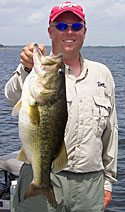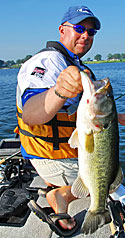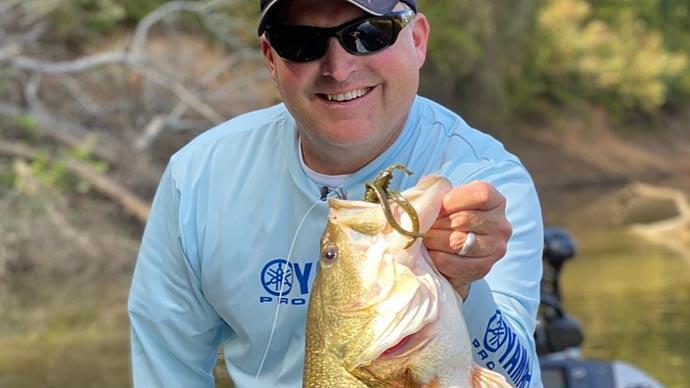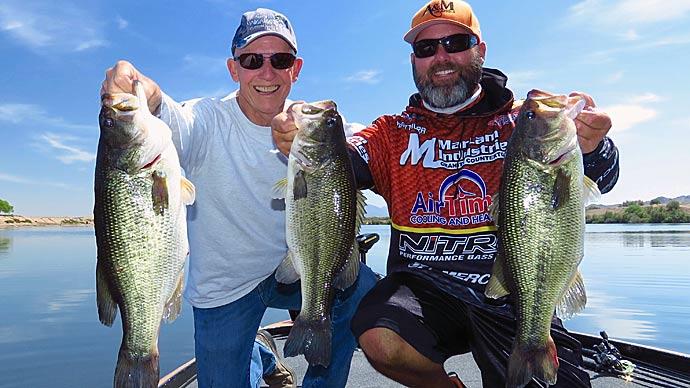
Once the heat of summer comes on, and bass move to deeper locations, the drop shot rig will likely be your best option for catching numbers of bass. While jigs, Texas rigs, and Carolina rigs often produce larger bass, these rigs will often struggle to keep up with the numbers that a drop shot can catch. And if the fishing turns tough, the drop shot will often save the day with some nice catches, while more conventional methods may only produce a few fish all day. Although many of you have already mastered this technique, I'm still surprised by the number of anglers that either refuse to fish with this "sissy technique" or by the anglers that have still never encountered a drop shot rig. Now through November is the perfect time to learn drop-shotting on Fork or any other lake in the country.
A drop shot rig is straightforward to tie up. There are many variations and specialty tackle items for the rig, but here's how I rig it. First, tie a 1/0 straight shank light wire hook with a Palomar knot, leaving an 18-inch long tag end. At the tag end, connect a 1/8- to ½-ounce Lake Fork Tackle Tungsten drop shot weight. The weight has a swivel built into it, virtually eliminating line twist issues. I use the 1/8-ounce weight when fishing around grass or wood cover in shallow water, while a 3/8- or ½-ounce weight works best when fishing in 15 feet or deeper and in more open water.
I rig all of this on P-Line Fluorocarbon line, as the fluorocarbon delivers a much better feel than mono while providing excellent abrasion resistance and extremely low visibility. I rig 10-pound test for most of my drop shots on Fork, while 6- to 8-pound test works well on extremely clear lakes without a lot of cover, especially for inactive pressured bass. If I'm fishing around heavy wood cover or very dense grass, I'll up my line to 12 or even 14- to 17-pound. With a correctly set drag and a little patience, I've landed big bass up to 9 pounds on Fork with only 10-pound test around brushy cover. If you're fishing around heavy cover, remember to retie and re-spool your line often, or you'll pay the consequences.
Finally, spinning reels will allow you to cast the light rigs better, but baitcasters do fine on the drop shots with ¼-ounce or bigger weights. Use a medium-light power rod with a fast tip for smaller drop shots and when using less than 10-pound test. I use a medium power rod with a fast tip for the drop shots with bigger lines and weights.
Once you have your drop shot tied up, it's time to select a bait. While just about any soft plastic lure can be fished on a drop shot, I go with a Lake Fork Tackle 6-inch Twitch Worm 75% of the time. Natural colors like shades of pumpkinseed, green pumpkin, and watermelon typically work best. If the bite is tough, I'll sometimes cut the top 2- to 3-inches off the worm, creating a 3- or 4-inch finesse worm. If there isn't much cover to snag in, your best bet is to either nose hook the worm or hook it through the middle "wacky style," leaving the hook point exposed either way. This exposed hook results in a very high hooking percentage. If you're fishing around a lot of wood cover, I'll rig the Twitch Worm weedless on the hook Texas Style, with the hook point protected inside the worm. Virtually any lure that you'd rig on a Texas rig will work on a drop shot. My other favorites are Baby Ring Frys, Zig Zags, Baby Fork Creatures, Magic Shads, and 3.5-inch Live Magic Shads. While green and brown color schemes work in these baits, shad colors work very well with the Magic Shads and Live Magic Shads.

Depending on the fish's mood, you can continuously shake the worm in place or dead-stick it and let it slowly fall to the bottom. I usually go with the former, continuously shaking my bait on a semi-slack line, so the bait is constantly dancing but keeping enough slack in the line, so the sinker stays on the bottom. Practice this in a swimming pool or cove with clear shallow water, and you'll quickly get it. I'll cast the drop shot out when the bass is less active and let the weight and bait fall to the bottom. Let your lure sit on the bottom for a few seconds, then slowly pick up the slack and raise the bait off the bottom without lifting the sinker off the bottom, then hold the bait in place for 5 to 60 seconds. Let the bait fall back to the bottom, and then pick it back up and hold it in place for another 5 to 60 seconds. Repeat this process back to the boat. Bites are rarely hard hits. Usually, your bait will get heavy. If your hook point is exposed, you'll only need a small wrist snap to set the hook, while you'll need a slightly stronger hookset if your bait is rigged weedless on the hook.
The other retrieve element to consider on your drop shot is whether to pitch, cast, or vertically jig it. Around shallow cover like docks, laydowns, brush piles, and isolated weed clumps, pitch a wacky rig just like you would a Texas rig. Out deeper, casting the drop shot over points, roadbeds, and humps works well. Even better, when a bass school is located in a specific area, a drop shot is a deadly weapon. Get directly over the fish with your boat, keep them on your screen with your depth finder, then drop the drop shot over the side of the boat and wiggle in the bass' faces until they bite. It's like sight fishing, only in much deeper water. This vertical presentation also works excellent for suspended fish. By watching your bait on the fish finder, you can keep your lure right in front of suspended bass and even watch them bite on the screen!
Next time you're looking to fill your limit quickly or find the bite slow on Texas and Carolina rigs, give the drop shot a try, and I think you'll like the results. Here's hoping you catch the lunker of your dreams.




